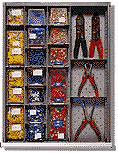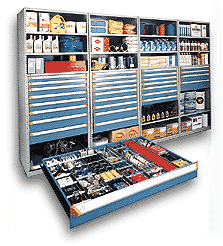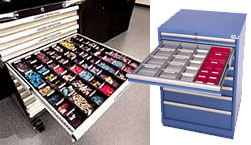Modular Storage Considerations
When to use cabinets, when to use drawer inserts for industrial shelving
 Something we often recommend to save space for our clients is modular drawer storage — for certain operations, in particular those with components, assorted small parts, hardware, or even tool storage, we’re talking about recouping 50% -70% of floor space. Once people have ’em, they love ’em.
Something we often recommend to save space for our clients is modular drawer storage — for certain operations, in particular those with components, assorted small parts, hardware, or even tool storage, we’re talking about recouping 50% -70% of floor space. Once people have ’em, they love ’em.
But there is more than one way to skin that cat. You can configure different kinds of cabinets to do different jobs. There are hundreds of possible combinations of drawer styles and sizes. Another wrinkle is what happens when you can merge the drawers with steel shelving. It can be new, it can be some you are already using. It begs the question: when is it better to have a cabinet, and when is it better to use shelving and compartmentalized drawer inserts?

When should you use shelving drawer inserts?
When you need to merge bulk and modular storage
You need to store bulkier items and smaller ones in the same space. This gives you flexibility and storage options for many items. Large boxes can be stored above the drawers or below if you chose a smaller set of drawers that are more elevated.
When you will not move it for a long period of time
Moving shelving with drawers is lots more difficult than a cabinet. Cabinets are easier to move than shelving; they can be mounted on wheels and often have forklift space below them, so they’re lots easier to move compared to shelving with drawers. Shelving is best used in applications where you know you won’t have to redo your layout in the near future. If you don’t need to merge it with shelves, and you think you’ll be reconfiguring in the relatively near future, cabinets are your answer.
When you’re concerned about ergonomics
If you have many orders or parts being picked from your drawers, this can be huge. With shelving-mounted drawers, you can elevate them to be at the right level for pickers. You eliminate bending and stretching by putting them exactly where the activity is going to happen.
When you want to add security to existing shelving
Shelving is many things – economical, reliable, stable, high-capacity, but one thing it isn’t is secure. That easy access is part of the point of shelving. Adding drawers gives you a lockable area within a storage media that wasn’t at all secure previously.
We’ve also seen shelf-mounted drawers used within a shelf supported mezzanines to great effect. You can simply retrofit the shelves in a confined and difficult to reconfigure spot like under a mezzanine with the drawers and you’re good to go (consult a pro before actually installing them in a mezzanine support shelf). This gives you a big boost in organization and storage within your existing storage cube.
 What about modular drawer cabinets?
What about modular drawer cabinets?
Cabinets with modular drawers offer the same things shelving does, but in a different package. This gives you some choices, and depending on your application, they’re good choices.
When you’re dealing only with small parts
If you don’t need the bulk storage capabilities of shelving, cabinets are the better choice. You can often mix in either a modular drawer shelving unit or some conventional shelving and get a similar effect. So if you have no need to have bulk/bin and modular storage in the same footprint, the flexibility of cabinets makes them the choice. If you don’t need the bulk and the smaller parts together, get a cabinet.
When you want to be able to reconfigure with less planning and effort
Cabinets can be moved much easier than a shelving unit. Okay that’s an understatement. They are EASILY moved — period. Shelving isn’t. A loaded cabinet can often be moved with a lift truck. Load it, drop it, use it. A mobile cabinet mounted on casters can be rolled anywhere you want with one hand. A shelving unit with drawers will probably have to be unloaded, moved and reloaded. Can’t really forklift it, can’t mount it on casters.
When you want maximum storage density for small parts
Even in applications where you can put bins on a shelving unit, modular drawers are going to take up less space and store more things. If you need to put a lot of parts, tools, or components in a space and room is a factor, go with a cabinet rather than shelving. You can even merge cabinets into vertical modular storage walls that really pack the parts into a tight space. Shelving by nature requires aisles, requires more vertical cube.
At the end of the day, though, it’s all about your application and what you’re trying to get from the equipment. More information on modular drawer applications can be found here.
Tags: tool storage, Industrial Shelving, small parts, modular storage, warehousing, Material Handling, security, space savings
Scott Stone is Cisco-Eagle's Vice President of Marketing with 35 years of experience in material handling, warehousing and industrial operations. His work is published in multiple industry journals an websites on a variety of warehousing topics. He writes about automation, warehousing, safety, manufacturing and other areas of concern for industrial operations and those who operate them.




 What about modular drawer cabinets?
What about modular drawer cabinets?